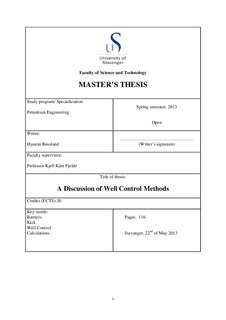| dc.description.abstract | Well control can in short words be described as the core for human safety on board a platform or a rig. It includes a variety of elements that go under the name barrier elements that are in place to prevent an unwanted inflow of formation fluids. They need to be functional in order to fulfil their purpose. Elements are made, controlled and replaced by people, it is therefore vital that the people working with them knows how they work in order to detect failure so they can be repaired or replaced as soon as possible. It is also important that everyone working in a drilling operation knows what well control is and the different scenarios that can develop if one should emerge.
On the Norwegian Continental Shelf the number one priority from the authorities are safety, this is what the industry chases in pursuit for black gold and high rewards. To secure their investment guidelines, procedures and standards are provided to the industry and it is required that the people working there knows what they say, understand them and work according to them. In this way everything is done to make sure that all operations are successful operations. This high safety focus ensures that workers can go home from work in the same physical condition as when they went to work in the morning, or when they left for their offshore period 14 days earlier.
The different well control methods are used for different situations depending on a variety of factors. This might be what depth the incident happened at, drill string position, personnel competence, and platform capacities to mention a few. For the Driller`s method (DM) and Weight and Wait (W&W) method, in many ways they use the same operational procedures when killing the well, but the thing that separates them from each other are when kill mud gets introduced into the system. Time consumption are also another aspect that separates them, where W&W uses less time compare to DM. W&W can also have an positive advantage, if the kill mud enters the annulus before the kick reaches the casing shoe, then it will be able to reduce the pressure from the kick acting on the casing shoe due to its heavier weight.
The Volumetric method and Bullheading method may be the best choice if the drill string is high up or out of the well, if the competence among the personnel is too low to perform a conventional kill method (DM and W&W), or if there are limitation within the equipment to handle the kick on surface etc. In these cases the Volumetric or Bullheading method may be the best choice when killing a well.
The selection of mud in the system is also an element related to well control, and knowing the different behaviour between WBM and OBM in the event of a kick is crucial and very important. To know the behaviour increases the chances of detecting a kick early and before it escalates into a large kick. In WBM, when a gas kick enter the wellbore it will occupy annulus space which can be observed at surface as pit gain. However, there is another process developing in the OBM, here the gas gets dissolved into the OBM and the chances of detecting this at surface are small. Also, also if the mud is stationary the kick will also be stationary until circulation starts up again.
When the circulation starts up the dissolved gas moves upwards in the annulus together with the mud, nothing happens, not until the well pressure gets reduced to the extent that it reaches the boiling pressure of the gas, or the flash point. What happen is that gas goes out of suspension and back into free gas, this will lead to a rapid displacement of mud, and the result can lead to, if they are unable to trap it in the well and it moves past the BOP, a surface blowout with unpleasant consequences.
With today`s search for more and remote black gold, drilling gets deeper along with more complex well paths which reduces the margins for errors. This increases focus and requirements to personnel`s experience and knowledge, and are one of the most important factor in terms of reducing the risk and consequence if an incident should happen.
One intention with this thesis is to shed light on different elements related to well control, in this way it is possible to increase the overall understanding a bit more. The second intention with the thesis is to give a broader understanding of four well control methods used today. Two of them will have a higher focus than the rest. Also the importance of knowing and understanding well control calculations is elaborated by calculation examples for several different well scenarios. Also different platform types are used for distinguishing between the different methods. Hopefully the thesis will contribute to a broader understanding of well control. | no_NO |
